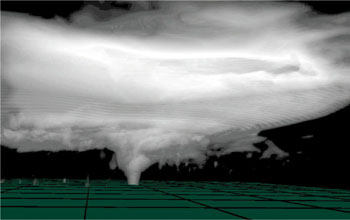Multimedia Gallery
Tornado Simulation
Tornado simulation of a 1977 supercell thunderstorm and the high-intensity tornado it spawned. The simulation captured the tornado's vortex structure with wind speeds of 260 miles-per-hour, classified as an F5 on the Fujita tornado intensity scale.
More about this Image
Ming Xue of the University of Oklahoma used the Pittsburgh Supercomputing Center's terascale computer system to run one of the largest tornado simulations ever created. Together with PSC's Greg Foss, who used Xue's numeric simulations to create a 3D visualization, Xue successfully simulated the 1977 supercell thunderstorm and tornado.
Xue is a team member with the NSF Engineering Research Center for Collaborative Adaptive Sensing of the Atmosphere. The research was supported by National Science Foundation grants ATM 0129892 and EEC 0313747. (Date of Image: May 2004)
Credit: Numerical simulation performed by Dr. Ming Xue, Center for Analysis and Prediction of Storms and School of Meteorology, University of Oklahoma; 3D visualization created by Greg Foss, Pittsburg Supercomputing Center, with assistance from Ming Xu
Images and other media in the National Science Foundation Multimedia Gallery are available for use in print and electronic material by NSF employees, members of the media, university staff, teachers and the general public. All media in the gallery are intended for personal, educational and nonprofit/non-commercial use only.
Images credited to the National Science Foundation, a federal agency, are in the public domain. The images were created by employees of the United States Government as part of their official duties or prepared by contractors as "works for hire" for NSF. You may freely use NSF-credited images and, at your discretion, credit NSF with a "Courtesy: National Science Foundation" notation.
Additional information about general usage can be found in Conditions.
Also Available:
Download the high-resolution JPG version of the image. (214.9 KB)
Use your mouse to right-click (Mac users may need to Ctrl-click) the link above and choose the option that will save the file or target to your computer.

